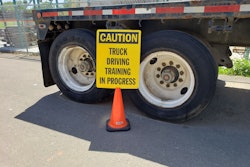The U.S. DOT appears poised to delay portions of a rule that, for the first time, will implement national training standards for new truck drivers. In a notice published last week, the DOT’s Federal Motor Carrier Safety Administration proposed a two-year delay to key provisions within the rule — provisions essentially meant to ensure that parties are complying with the new training standards.
The rule, officially titled Minimum Training Requirements for Entry-Level Commercial Motor Vehicle Operators (but more colloquially known as the entry-level driver training rule), was published in late 2016, providing more than three years for trainers, states and the agency itself to prepare for the Feb. 7, 2020, effective date.
While the delay is not yet final, it’s unlikely the agency will back off its proposal to bump the compliance date of the enforcement protocol by two years — to February 2022, instead of February 2020. The delay is intended give the agency and state driver’s licensing agencies more time to deploy the necessary IT infrastructure to transmit and receive training certificates.
An FMCSA spokesperson said via email last week that the agency is working with its state licensing partners, and that the extension will give them more time to gather feedback from states and “make the implementation of the rule as effective as possible.”
The agency is adamant that the standards themselves — the required classroom curriculum and required behind-the-wheel training — should be adhered to starting Feb. 7, 2020.
Though the standards take effect in a little more than six months, as does the requirement that training providers (including carriers who train in-house) register within FMCSA’s Trainer Provider Registry, the rule has effectively been defanged — at least for the extra two-year period proposed by FMCSA. In effect, states will have no way to verify that drivers received training from a registered provider before issuing a CDL — the crux of the entry-level driver training rule.
“We view it as taking the enforcement arm out of the rule,” says Laura McMillan, vice president of training and development at Instructional Technologies, a provider of training tools and software for fleets and driver trainers. “Apart from knowing who is registered, [FMCSA] won’t have that paper trail or digital certificate to identify students who have completed the curriculum from qualified providers.”
The delay allows an exiting loophole to fester, she says, as state licensing agencies can’t — or won’t have to — confirm that drivers have been properly trained before issuing a state-issued CDL knowledge or skills test.
Likewise, the Commercial Vehicle Training Association called the delay “problematic,” as it creates “enforcement and safety” concerns.
Both CVTA and McMillan advocate for a stopgap measure to help bolster the rule in the two-year interim.
“There are web-based applications that can be a temporary fix, to help connect the dots,” between trainers, FMCSA and state licensing agencies, says McMillan. “There are electronic solutions that are low cost, from our perspective, for FMCSA to consider and to not just put [the rule] on the shelf without an intermediate option.”
Likewise, CVTA President Don Lefeve says the group “urges FMCSA to consider establishing a database to accept individual certifications,” or, as an alternative, at least a printed certificate that states can use to verify they received training from a certified provider.
The agency is accepting public comments for 30 days — until Aug. 19 — at this link.
McMillan encourages stakeholders to comment, to help guide the agency’s decision and to offer alternative solutions. In the meantime, she encourages trainers — including carriers with training schools — to proceed with adopting the curriculum and training requirements of the new rule, both to ensure drivers are being trained properly and to help provide FMCSA with data to speed full implementation of the rule.













